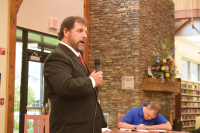Waynesville could finally see long-awaited make-over of South Main Street
Waynesville’s South Main Street — the two-lane thoroughfare that is the major artery between downtown and the new Super Wal-Mart — could be increased to four lanes and even have roundabouts, according to preliminary redesign options recently laid out by the Department of Transportation.
Town officials have been hounding DOT for more than a decade to redesign the corridor, which also serves as one of the gateways to Waynesville.
The DOT made forays into a feasibility study for the road in 2002, but the plan went nowhere and was shelved.
South Main Street is now back on the drawing board. Town leaders are hopeful the DOT will come up with a redesign that fits in with the town’s land use plan and makes South Main Street more pedestrian friendly and aesthetically pleasing.
South Main Street has long been the neglected end of town. The need to redesign the dated corridor has grown more urgent since the arrival of Super Wal-Mart in 2008. The two-lane road is no longer able to handle the amount of traffic that has been added as a result of the megastore and buildings that have sprung up around it. According to DOT, 18,400 vehicles per day are coming and going in the vicinity of Super Wal-Mart.
“We needed something addressed,” said Mayor Gavin Brown. “It’s not going to go away — it’s an issue and it’s a problem.”
DOT has laid out several redesign options to study. One calls for widening the thoroughfare to four lanes from Hyatt Creek Road, just next to the Super Wal-Mart, all the way to U.S. 276 right at the edge of downtown. A raised median would be placed in the middle.
Another option calls for widening the road to four lanes about half way to downtown — near the Waynesville Inn Golf Resort and Spa, i.e. country club — then to three the rest of the way. Roundabouts could be included in the three-lane section.
A third option would maintain the road as a two-lane corridor and implement intersection improvements such as roundabouts.
The options differ from those offered up in the 2002 study, before the town’s land use plan was in place. That study recommended a four-lane divided road with extra turn lanes in some places at a cost of $27 million. The old study estimated that 30 businesses and a dozen residential homes would be displaced by the redesign.
Starting early last year, town officials pressed DOT to revisit the feasibility study so it incorporated the town’s land use plan. The town opposes major widening of the road all the way into downtown or through residential stretches, Brown said.
In the commercial area, the town does not want a five-lane road, Brown said, preferring a four-lane road with a landscaped median in lieu of a middle turn lane.
In addition, the town wants eight-foot wide sidewalks on either side of South Main Street to accommodate bicycle and pedestrian traffic and street trees lining the corridor.
“Sidewalks are necessary for the safety issue — people are going to walk to these facilities,” Brown said, referring to the new Super Wal-Mart, Best Buy, and other businesses that have cropped up around them. Currently, the sidewalks lining South Main Street are patchy at best, and at points, disappear completely, leaving pedestrians dangerously close to oncoming traffic.
The initial plan didn’t include sidewalks — in fact, the new plan likely wouldn’t either if the town didn’t make it a priority to push for them.
“The DOT is very focused on automobile transportation, and they talk about being multi-modal, but I’ve seen them be pretty reluctant to include things like bike lanes and sidewalks because its an extra expense,” said town planner Paul Benson. “If the town wants to see amenities like that, we’ve got to get involved.”
By all indications, that’s just what Waynesville officials have done. Brown said he’s called the DOT every two months for the past year to check on the status of the study.
In an telephone conference with DOT designers in January, the town voiced concern over whether an overly wide road would be compatible with the town’s design guidelines and vision for the corridor. Town officials reiterated their wishes for sidewalks and street trees.
Brown said the regional DOT office has been very willing to work with the town and has helped them communicate their wishes to the state office.
“They completely understand the town’s vision and were very supportive of my comments,” Brown said of the regional Division 14 office.
DOT Feasibility Studies Unit Head Derrick Lewis cautions that the new designs being studied could change depending on the input of local leaders.
“We’ve changed our process to actively solicit government input at multiple points within the process,” Lewis said. “We’re just trying to get it closer to what everybody wants, and we actually get a better product in the long run.”
Lewis said the DOT will also seek public input early in the process, before the final designs are laid down. Members of the public will be invited to share their ideas and concerns at a workshop this summer.
Town officials promise to be vigilant in making sure the final product reflects the town’s vision.
“If we don’t like what we see, we’ll lobby for changes,” said Benson.
Precarious boulder prompts creative action by DOT
There’s a big problem looming over a rural Swain County road — literally — and exactly how to solve it is befuddling Department of Transportation officials.
A rock slide earlier this month sent several SUV-size boulders crashing into Buckner Branch Road, and left one dangling precariously about 70 feet over the road below.
The force of the rocks that did fall would have caused major damage to a vehicle, said Jonathan Woodard, DOT District 14 Engineer. Luckily, no one was driving past that stretch at the time.
“Some rocks bounced plumb over the road, ripped through the guardrail and went into the river,” Woodard said. “A car would have been crushed or drug into the river.”
DOT officials don’t want that fate to befall someone else should the remaining boulder become unlodged. So they’ve closed off the road. But so far, the boulder refuses to budge — despite the best efforts of DOT officials.
“We’ve dealt with similar situations, but what makes this unique is that the area is so steep, and there’s no good way to access it,” Woodard said. To remove the rock “is going to take being pretty creative,” he said.
So in the past three weeks, DOT workers have pulled on their thinking caps in an effort to solve the problem. They recruited the Bryson City Fire Department, who attempted to hose the rock out of position. It didn’t work.
“We tried to wet down the ground underneath it with water to try and wash some of the debris out from under it, but most of the water just disappeared,” Woodard said.
Workers, stumped, tried another approach. They hooked a cable to the rock, and another end to a bulldozer. They tried to pull or spin the rock off with the dozer.
“It wouldn’t budge,” said Woodard.
Finally, DOT workers think they’ve come upon a solution. They plan to drill a hole in the rock and dynamite it, breaking it into manageable pieces. Then, they’ll hire a company to install a rock catchment fence first. Bids have already been put out to find a contractor for the project.
The DOT will also have to shift the road over about 10 feet toward the river bank. The river is part of Fontana Lake and thus property of the Tennessee Valley Authority, so the DOT is working to secure TVA’s permission.
The road will remain closed in the interim, forcing a detour of 20 minutes the other way to get to town.
Some residents, reluctant to take on the additional drive time, continue to brave the stretch instead. Several vehicles could be seen last week traveling over the muddy, broken pavement, their drivers picking up speed momentarily as they passed under the precrious boulder.
Task force aims to fix future traffic snarls
A Jackson County task force has entered the nitty-gritty stage in its quest to fix traffic congestion on N.C. 107 in Sylva.
The group has begun compiling a long list of possible solutions to the congestion. Once complete, it will turn the list over to the Department of Transportation to assess whether and how much each idea could help.
The solutions fall into one of two categories. One is to alter the design of N.C. 107 to handle more traffic. The other is to divert cars off N.C. 107.
Jackson County is split into two basic camps of how to solve traffic congestion on N.C. 107. One advocates building the Southern Loop, a cross-county highway that would bypass the main drag of N.C. 107 and tie in with U.S. 23-74 north of Sylva. Initially conceived as a large-scale freeway, road planners now say it could be a boulevard or even simple two-lane road.
The second camp wants to redesign the existing N.C. 107 and use smaller side roads to handle some of 107’s traffic.
Just how much congestion the task force is tasked with solving has been the subject of debate over the last several months (see related article.) The latest prediction claims there will be around 1,000 to 2,000 cars too many using N.C. 107 during the peak commuter hours by the year 2035.
The projection was formulated using DOT models and growth formulas, and massaged with help of the task force.
Some members of the task force remain concerned over the growth assumptions plugged into the model. The pace of growth witnessed over the past 25 years may not hold true for the next 25.
“Then this overage you are trying to address may not be accurate,” said task force member Susan Leveille.
Those in favor of the Southern Loop want to make the future congestion look worse to justify the road, Leveille said. Likewise, those who don’t want to build the Southern Loop want to downplay future congestion.
Diverting traffic
The name of the game is figuring out how to deal with 1,000 to 2,000 more cars than the road can handle. That’s where the brainstorming process and solutions pitched by the task force come in.
Those opposed to the Southern Loop hope to shows the overage can be handled without building a new highway. Those in favor of the Southern Loop claim the only way of dealing with that many cars would be building the new bypass.
The Southern Loop isn’t the only way to divert cars off 107, however. There are other ways to lighten the load. One is a system of smaller network roads: a system of shortcuts, more or less.
Another option for lightening the load doesn’t involve the roads at all. For example, if more students and faculty lived in Cullowhee, they wouldn’t be driving up and down N.C. 107 to get to campus. The county could enact land-use strategies to encourage more residential development around Western, according to Pam Cook, a DOT transportation planner working with the task force.
“That would be something that only elected officials can change, but that can certainly be evaluated,” she said.
Another option to get cars off the road is a commuter bus between Sylva and Western Carolina University in hopes of decreasing cars on the road.
When it comes to altering the design of N.C. 107 to handle the traffic overage, solutions being pitched include rerouting intersections, adding lanes and congestion management strategies.
Some solutions, when packaged together, can actually result in exponential improvements. For example, an intersection redesign could increase carrying capacity by 2,000 cars and an extra lane by another 2,000, but when done together could carry an extra 5,000.
“We’ll try to strategically group those,” said Ryan Sherby, community transportation coordinator for 10 western counties.
A whole category of solutions falls under the umbrella of congestion management. Congestion management can streamline traffic and increase what the DOT calls the “carrying capacity” of the road. But the congestion strategies might not be included in the numbers game aimed at coping with the projected overage, Cook said.
But the techniques are being considered. A team that specializes in congestion management visited Jackson County and performed a cursory analysis of N.C. 107 last year at the behest of the local DOT. The report from their visit is not yet out, but could be promising, Cook said.
“They may not solve all the deficiencies but would certainly make things operate more smoothly,” Cook said.
Cook said the team would like to make a second visit to examine a few options more closely.
The public can join in the brainstorming as well. Anyone with a solution they think the task force should put on the list to run by DOT can contact Sherby at This email address is being protected from spambots. You need JavaScript enabled to view it. or 828.586.1962, ext. 214.
Stop-and-start process now rolling
Jackson County task force members are excited with the new stage of their work. The task force was formed six years, but faltered for much of its existence due to a revolving door of DOT staffers, including long windows with no staff person assigned to the task force at all.
“I feel like we are just getting started with what I thought would be happening five years ago,” said Susan Leveille, a task force member and representative of the Smart Roads coalition. “We have been sitting listening for such a long time, and for a long time we had a void of nothing. I am very glad that we finally have an opportunity for input that seems to be genuinely part of the process.”
The current DOT staffer assigned to the task force marks the fourth since its creation, and each one essentially started again from scratch upon taking over. But the latest at the helm, Pam Cook, appears to be in for the long haul and the task force is finally showing concrete progress.
Cook said every solution pitched in the brainstorming stage will get evaluated.
“Every thought needs to be considered. Some can just be considered by discussion, some thoughts will be evaluated through a model, others we’ll have to go out into the field and see if it is feasibly possible to connect this road and that,” said Cook, who specializes in community transportation planning. “There is not a bad idea.”
First things first: How many cars too many?
The Jackson County transportation task force has spent the past several months signing off on a projected traffic count for the future, namely the year 2035. Until road planners had a projection in front of them, they didn’t know what kind of overage they were dealing with, and whether the problem was a small one or big one.
“One of the driving forces behind any road in the future is the traffic projection for 2035, which is our horizon year right now,” said Ryan White, DOT project coordinator in Raleigh. “If we add no signals, no connecting roads, no bypass, in 2035, how is N.C. 107 going to operate? We have to establish there is truly a problem and that will show there is some type of improvement that is needed.”
White is coordinating the planning process for the Southern Loop, which is on a parallel track to the task force. While the task force brainstorms its solutions, the DOT is engaged in the planning process for the Southern Loop. If and when the Southern Loop is chosen as the best solution, the DOT will have a head start on the otherwise lengthy process of building a major new road.
The congestion projected for 2035 turns out to be only mediocre rather than terrible, according to Ryan Sherby, community transportation coordinator for 10 western counties.
Traffic models pinpointed the main drag of N.C. 107 from Lowe’s to the intersection has more cars than it can handle — about 1,000 to 2,000 too many during peak commuter times. The intersection of N.C. 107 and U.S. 23-74 was flagged as a problem area of its own.
“It pretty much showed what we all expected,” Sherby said.
But there are other areas in the county that will be experiencing traffic congestion by 2035 as well, including part of Main Street and Centennial Drive on the WCU campus.
Southern Loop planning has stalled somewhat in a quest for the best traffic projections. The numbers massaged by the task force were considered more up-to-date than the ones the DOT was using, so they are redoing their models accordingly. When done, White will know not only the volume of cars, but theoretically how they are moving along the road.
“We can see how cars are driving and turning,” White said.
Community lobbies DOT to save a piece of history
Citizens in the Oak Grove community of Macon County hope to save a bridge from demolition by the Department of Transportation.
Located off N.C 28, the one-lane McCoy bridge over the Little Tennessee River is not only a community icon but part of the cultural heritage of the area, says Doug Woodward of Oak Grove, who has joined his neighbors in a campaign to get the bridge refurbished rather than replaced.
DOT met with the community last week and agreed to look into the costs of repairing the bridge rather than tearing it down and replacing it, but the state maintains that the old bridge is rife with problems.
DOT finds fault with bridge
DOT officials say the structure needs to be replaced because it is dangerous and not up to state standards. Plans call for replacing it in 2013. But DOT has agreed to consider rehabilitating the bridge, and will report back to the community with a follow-up meeting in about a year.
“We’re going to go back and take a deeper look at rehabilitation to see if something is economically feasible,” said Chris Lee, DOT bridge maintenance engineer.
“It has been deteriorating for years,” said Charles McConnell, DOT transportation supervisor.
The bridge’s legal load limit is 40,000 pounds, when state standards say it should be 90,000 pounds. McConnell said a small loaded dump truck could not go over the bridge.
The bridge is also narrow at just 10 feet and 8 inches wide, making it difficult for school buses to cross.
“It has quite a few issues,” McConnell said.
Lee noted that the bridge is one lane, so motorists have to take turns with vehicles coming from the other direction.
The bridge also has “foundation issues” from the timber pilings, Lee said.
The bridge is a “fracture critical structure,” meaning that if one piece fell off the entire bridge could collapse, Lee said.
He said the bridge in Minneapolis that collapsed was also a fracture critical structure.
Ultrasonic testing has taken place on the bridge, indicating that “the bridge is about finished with its life,” Lee said.
The state doesn’t have a cost estimate on the rehab.
“It’s very easy for an overloaded vehicle to go over it tomorrow and the whole thing to fall in the river,” Lee said. “Then we’ve got big problems.”
Heritage at stake
McConnell sad the bridge isn’t historical since it was just built in 1960. Woodward said the community believes the bridge dates back to 1946.
The unique truss architecture of the bridge is rare these days, and it should be preserved, Woodward said.
“These bridges are disappearing,” Woodward said.
The bridge suits the beautiful rural setting, where whitetail deer are a common sight.
“It’s at an end of the county where there’s a lot of untouched history,” Woodward said.
The area has been spared of the development that has ransacked other areas in the mountains, making a trip to Cowee like stepping back in time, Woodward added.
The historic bridge belongs in the area rich with other historic sites including Cherokee mounds and the Cowee-West’s Mill Historic District, Woodward said.
The bridge is located near old Cherokee settlements, including Burningtown, said Cowee resident Lamar Marshall, who also wants the bridge to stay.
Replacing the bridge would cost an estimated $3.5 million to $4.5 million, Woodward said.
“We’re saying (DOT) is dismissing rehab too quickly,” Woodward said, adding he would like to see the cost estimate on refurbishing it.
Woodward, a retired engineer, says rehab is viable.
He added that no one’s ever been hurt as a result of the bridge’s age, and few vehicles drive on it.
Park-and-ride in Haywood gains traction
A shuttle to transport commuters between Haywood and Buncombe counties is gaining momentum following the state’s recent offer to donate land for a park-and-ride lot.
The proposed lot is at Exit 33 along I-40 in Canton on land owned by the Department of Transportation. The DOT would pay to pave and light the lot, according to Mark Clasby, Haywood County’s Economic Development Director.
The acquisition of land for the park and ride is a final piece of the puzzle to getting the system up and running. A vehicle to shuttle riders will come from the non-profit Mountain Projects agency, which already operates public transportation internally within Haywood County.
The park and ride system would target the some 4,000 Haywood residents who work in Buncombe County, a number estimated by the U.S. Census Bureau. Users looking to save gas and money or avoid traffic would park their vehicles in the lot, pay a fare and take public transit to one of two or three dropoff sites in Bumcombe. Exit 50 near Mission Hospital and the Asheville Transit Authority have been debated as possible dropoff locations.
The Smoky Mountain News first reported on a potential park and ride system for Haywood in July, when Mountain Projects, the nonprofit agency in charge of the county’s public transit, received a grant to develop a transportation system between Haywood and Buncombe counties.
At the time, commuters who were told about the idea expressed an interest in learning more. Many said cost was a major factor in whether they would take public transportation. A shuttle would have to save them money before they would consider trading in the freedom of having a personal vehicle. Keeping costs low is a challenge for public transportation, since drivers must be paid and buses must be filled in order to break even.
Though a timeline has not been set, the project will likely continue to move forward since it has garnered support from several bodies, including the county commissioners and Haywood Community College.
“I think this is a good thing,” said Commissioner Skeeter Curtis.
DOT takes input on N.C. 107 project
Jackson County residents weighed in on proposed road improvements for N.C. 107 at a citizens informational workshop Feb. 25 at Western Carolina University’s Ramsey Center.
DOT accused of convoluted planning
Opponents to the Southern Loop again urged the N.C. Department of Transportation to halt planning for the new highway last week during a meeting of the Jackson County Transportation Task Force.
Mountain roads cited as among the state’s most dangerous
By Julia Merchant • Staff Writer
Driving a tractor-trailer in Haywood County or a motorcycle in Swain? Use caution. Both counties top the list of AAA Carolinas recently released report on the most dangerous places to drive in North Carolina.
Public weighs in on future of U.S. 441
By Jennifer Garlesky • Staff Writer
Progress on Jackson County’s corridor study for U.S. 441 is taking shape after three public meetings last week.





